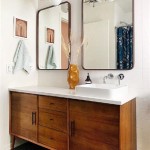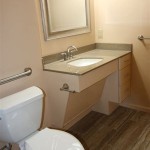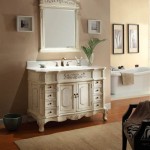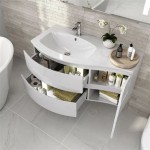Choosing the Right Downlight Colour for Bathroom Walls
Selecting the appropriate downlight colour for bathroom walls is a crucial aspect of bathroom design, impacting both aesthetics and functionality. The colour of the light emitted from downlights profoundly affects the perceived colour of wall finishes, the overall mood of the space, and the visual clarity. A careful consideration of various factors is required to ensure the chosen downlight colour complements the bathroom's design and serves its intended purpose effectively.
The term "downlight colour" generally refers to the correlated colour temperature (CCT) of the light source, measured in Kelvins (K). This measurement indicates the perceived warmth or coolness of the light. Lower Kelvin values (e.g., 2700K - 3000K) produce a warmer, yellower light, while higher Kelvin values (e.g., 4000K - 6500K) produce a cooler, bluer light. The selection of the optimal CCT for bathroom downlights depends on a variety of factors, including the existing colour scheme, the desired ambiance, and the tasks performed within the space.
Understanding the Impact of Colour Temperature on Bathroom Aesthetics
The colour temperature of downlights significantly influences how wall colours are perceived. Warmer light, with its yellow undertones, can enhance the warmth and richness of earthy tones, such as beige, cream, and warm greys. It can create a cozy and inviting atmosphere, suitable for relaxation and unwinding. However, warmer light can also subdue cooler colours, such as blues and greens, making them appear less vibrant.
Cooler light, on the other hand, provides a brighter, more energizing illumination. It enhances the clarity and vibrancy of cooler colours, such as blues, greens, and purples, creating a fresh and clean aesthetic. Cooler light is also beneficial for tasks requiring precision, such as applying makeup or shaving. However, excessive use of cool light can create a stark and sterile atmosphere, which may not be desirable in a bathroom intended for relaxation.
The choice between warm and cool light depends largely on the existing colour palette of the bathroom. If the walls are painted in warm tones, warmer downlights can amplify the cozy atmosphere. If the walls are painted in cooler tones, cooler downlights can enhance the freshness and vibrancy of the space. A balance may be achieved by mixing different colour temperatures in various areas of the bathroom, providing both task lighting and ambient lighting.
Furthermore, consider the colour rendering index (CRI) of the downlights. CRI is a measure of how accurately a light source renders the colours of objects compared to a natural light source. A higher CRI (closer to 100) indicates more accurate colour rendering. In bathrooms, where tasks such as makeup application and skincare are often performed, a high CRI is important to ensure that colours are accurately represented.
Matching Downlight Colour to Bathroom Decor and Style
The overall decor and style of the bathroom should also guide the selection of downlight colour. A traditional bathroom with classic fixtures and warm-toned walls may benefit from warmer downlights to enhance the traditional ambiance. A modern bathroom with sleek lines, minimalist decor, and cool-toned walls may be better suited to cooler downlights that accentuate the modern aesthetic.
For bathrooms with natural stone or tile finishes, the colour temperature of the downlights can significantly impact the appearance of these materials. Warmer light can bring out the natural warmth and textures of stone, while cooler light can highlight the cool tones and veining. Experimenting with different colour temperatures can help to determine the optimal lighting for showcasing these natural materials.
Consider the colour of the bathroom fixtures and accessories when choosing downlight colours. If the bathroom features chrome or stainless steel fixtures, cooler downlights can complement these materials, creating a modern and sophisticated look. If the bathroom features brass or gold fixtures, warmer downlights can enhance their warmth and luxury.
Ultimately, the goal is to create a cohesive and harmonious lighting scheme that complements the overall decor and style of the bathroom. This requires a careful consideration of the existing colour palette, the materials used, and the desired ambiance. It may be beneficial to test different downlight colours in the space before making a final decision, to ensure that the chosen lighting scheme achieves the desired effect.
Considering Functionality and Intended Use of the Bathroom
The intended use of the bathroom plays a crucial role in determining the appropriate downlight colour. Bathrooms serve a variety of functions, including showering, shaving, applying makeup, and relaxing. Each of these activities requires different levels and types of lighting.
For tasks requiring precision, such as applying makeup or shaving, cooler downlights with a high CRI are recommended. Cooler light provides better visibility and allows for more accurate colour perception. Consider installing brighter downlights in the vanity area to provide adequate task lighting. Dimmable downlights are also a valuable option, allowing users to adjust the light level according to their needs.
For relaxation and unwinding, warmer downlights with a lower Kelvin value are more suitable. Warmer light creates a cozy and inviting atmosphere conducive to relaxation. Consider installing dimmer switches to allow users to further adjust the light level to create a more relaxing ambiance. In areas such as the bathtub or shower, softer, warmer downlights can enhance the sense of tranquility.
In larger bathrooms, it may be beneficial to create distinct lighting zones to accommodate different activities. For example, the vanity area could be illuminated with cooler downlights for task lighting, while the bathtub area could be illuminated with warmer downlights for relaxation. This approach allows for greater flexibility and control over the lighting in the bathroom.
Nightlights are another important consideration for bathroom lighting. A dim, warm-toned nightlight can provide safe and comfortable illumination during the night without disrupting sleep patterns. Nightlights can be integrated into downlights or installed separately. The colour temperature of the nightlight should be warm and subtle, typically around 2700K or lower.
In conclusion, determining the optimal downlight colour for bathroom walls involves a multi-faceted approach, encompassing aesthetic considerations, functional requirements, and personal preferences. By carefully considering the colour temperature, CRI, decor style, and intended use of the space, a lighting scheme can be created that enhances the beauty and functionality of the bathroom.

Can Downlights Be Used In The Bathroom Elesi Blog

Premium Quality Bathroom Lighting Downlights Direct

Bathroom Lights Downlights Wall Boscolighting

Bathroom Lights Downlights Wall Boscolighting

Minisun Bathroom Ip65 Downlight In Chrome Value Lights

How Many Downlights In The Bathroom Elesi Blog

Ip65 Rated Surface Mounted Spotlight For Wet Areas

Most Energy Efficient Bathroom Downlights Arrow Electrical

Bathroom Lighting Ideas Tips Downlights Co

The Best Gu10 Leds For Your Bathroom Expert Guide







